[Retracted] Novel Analysis of Fuzzy Physical Models by Generalized Fractional Fuzzy Operators
Abstract
The present article correlates with a fuzzy hybrid technique combined with an iterative transformation technique identified as the fuzzy new iterative transform method. With the help of Atangana-Baleanu under generalized Hukuhara differentiability, we demonstrate the consistency of this method by achieving fuzzy fractional gas dynamics equations with fuzzy initial conditions. The achieved series solution was determined and contacted the estimated value of the suggested equation. To confirm our technique, three problems have been presented, and the results were estimated in fuzzy type. The lower and upper portions of the fuzzy solution in all three examples were simulated using two distinct fractional orders between 0 and 1. Because the exponential function is present, the fractional operator is nonsingular and global. It provides all forms of fuzzy solutions occurring between 0 and 1 at any fractional-order because it globalizes the dynamical behavior of the given equation. Because the fuzzy number provides the solution in fuzzy form, with upper and lower branches, fuzziness is also incorporated in the unknown quantity. It is essential to mention that the projected methodology to fuzziness is to confirm the superiority and efficiency of constructing numerical results to nonlinear fuzzy fractional partial differential equations arising in physical and complex structures.
1. Introduction
Fuzzy set theory is also an effective methodology for analyzing unpredictable scenarios. These ambiguities can arise in each part of a fractional equation, such as initial and boundary conditions. As a solution, determining fractional models in real-world settings allows for implementing interval or fuzzy formulations. The fuzzy set theory has been widely applied in many domains, i.e., topology, fixed-point theory, integral inequalities, fractional calculus, bifurcation, image processing, consumer electronics, control theory, artificial intelligence, and operations research. The area of fractional calculus, which includes fractional-order integrals and derivatives, has gotten a lot of interest from scholars and scientists in the recent several decades. Fractional calculus has many applications in modern physical and biological processes, with precise and accurate conclusions. In fractional differential calculus, the integral (differential) operators have a larger level of freedom. As a result, scholars have taken a keen interest in this field. A plethora of research articles, monographs, and books have been produced in recent years, covering a wide range of topics such as existence theory and analytical results [1–6]. Modern calculus has been implemented to a wide range of topics in applied sciences where data is uncertain. Zadeh [7] proposed the fuzzy set to deal with similar issues. Fuzzy relations and fuzzy control were defined further by Chang and Zadeh [8]. Fixed point theory, topology, algebra, control systems, and fuzzy logic, among other fields, use fuzzy set theory. The investigators developed elementary fuzzy calculus, fuzzy set-based [9, 10]. Dobius and Prada established the fundamental idea of fuzzy integral equations [11]. Fractional integral and differential equations have gained appeal among scholars in recent years. As a result, fuzzy calculus was prolonged to fuzzy fractional integral equations and fuzzy fractional differential, with several biological and physical implications. It is best to use a fuzzy idea to specify the parameters rather than a crisp number when studying problems where pieces of information are uncertain. As a result, numerous scholars have focused on studying fuzzy fractional differential equations in diverse directions. In [12–15], several basic difficulties are investigated. The Atangana-Baleanu Caputo derivative [16], a nonsingular fractional derivative suggested by Attangana, Balaneau, and Caputo, has recently gained prominence among scholars [17–20]. Fuzzy derivatives can be used to calculate fractional differential equations under the ABC derivative, leading to a variety of fascinating conclusions and new directions for young researchers.
Fuzzy fractional calculus theory is a prominent topic of mathematics that spans a wide range of mathematical structures in both theoretical and practical applications. In this arena, traditional derivatives are highly reliant on Caputo-Liouville or Riemann-Liouville issues. The common fault of these two qualifiers is the nonlocality and singularity of the kernel function noticed in the integral operator’s side by side with the normalizing function occurring alongside the integral ticks. Indeed, the real-world core replicating dynamic fractional systems, which cannot be denied, must yield a more productive and straightforward definition. This orientation introduces a new fractional fuzzy derivative construct, Atangana-Baleanu Caputo, which is used to generate and communicate new concrete fuzzy mathematical ideas. Because the kernel is based on the nature of exponential decay, the new fuzzy fractional Atangana-Baleanu Caputo derivative appears to be releasing singularity with the local kernel function, making fuzzy fractional differential equations more genuine in the creation of diverse uncertain models [21–25].
In various scientific fields, such as control theory, plasma oscillation, fluid flow, quantum mechanics, electromagnetic, biomolecular dynamics, nonlinear optics, and population growth, fractional differential equations have recently gained much attention as appealing mathematical tools for modeling several complex nonlinear phenomena. Caputo-Katugampola, Grunwald, Coimbra, conformable, Caputo, Riesz, Riemann-Liouville, and Caputo Fabrizio’s fractional ideas are among the many local and nonlocal fractional notions in the literature. Nonlocal derivatives are more intriguing than local derivatives since most physical implementations rely on historical and nonlocal features. Some of these operations, such as Caputo and Riemann-Liouville, have been proposed based on singular kernels. Recently, the fractional derivatives based on nonsingular kernels given by Caputo-Fabrizio [26] and Atangana-Baleanu [27] have been presented to represent physical dissipative phenomena better and reduce numerical collision when in comparison to other traditional fractional derivatives.
Gas dynamics are mathematical formulations of conservation rules found in engineering, i.e., mass conservation, momentum conservation, and energy conservation. Jafari et al. [28], Jawad et al. [29], Elizarova [30], Evans and Bulut [31], and Steger and Warming [32] used several analytical and numerical approaches to solve various types of gas dynamics equations in physics. Aziz and Anderson [33] used a pocket computer to tackle several gas dynamics problems in 1985. Rasulov and Karaguler [34] used a different approach to solve nonlinear system of equations problems in gas dynamics for a category of discontinuous functions in 2003. Liu [35] published a paper in 1990 on nonlinear hyperbolic-parabolic partial differential equations in gas dynamics and mechanics. Biazar and Eslami [36], Das and Kumar [37], and Kumar et al. [38] have recently applied the homotopy perturbation transform method and differential transform to solve the homogeneous and nonhomogeneous time-fractional gas dynamics problem.
The rest of the article is divided as follows. In Section 2, we give basic definitions of fractional calculus, fractional fuzzy derivative, and fuzzy set. The general methodology of the present method is in Section 3. In Section 4, to detect the validity and effectiveness of the suggested algorithm, we present some numeric problems. Meanwhile, we present the results in figures to see the effect of the Atangana-Baleanu-Caputo operator to the considered model. Finally, the conclusion will be drawn in the last section.
2. Basic Notions of Fractional and Fuzzy Calculus
This portion shows clearly several important components related to the fuzzy set theory and fractional calculus, as well as specific discussion of results about the Shehu transform. For further information, we refer the reader to [39].
Definition 1. We suggest that φ : ℝ ↦ [0, 1] is a fuzzy set, then, it is known to be fuzzy number if it holds the subsequent assumptions [39–42]:
- (1)
φ is normal (for some η0 ∈ ℝ; φ(℘0) = 1)
- (2)
φ is upper semicontinuous
- (3)
φ(℘1ω + (1 − ω)℘2) ≥ (φ(℘1)∧φ(℘2))∀ ω ∈ [0, 1], ℘1, ℘2 ∈ ℝ,, i.e., φ is convex
- (4)
cl{℘∈ℝ, φ(℘) > 0} is compact
Definition 2. We define that a fuzzy number φ is r-level set expressed as [39–42]
Definition 3. The parameterized version of a fuzzy number is denoted by such that r ∈ [0, 1] fulfills the following assumptions [39–42]:
- (1)
φ(r) is left continuous, nondecreasing, bounded over (0, 1] and left continuous at 0
- (2)
φ(r) is right continuous, nonincreasing, bounded over (0, 1] and right continuous at 0; 3.
Definition 4. For r ∈ [0, 1] and Y to be a scalar, assume that there are two fuzzy numbers [39–42] , then, the subtraction, addition, and multiplication, respectively, are stated as
Definition 5. Suppose a fuzzy mapping having two fuzzy numbers [39–42] , then, Θ-distance between and is represented as
Theorem 6. Consider a fuzzy valued function such that and r ∈ [0, 1]. Then [39–42]:
- (1)
(η0; r) and E(η0; r) are differentiable, if E is a (1)-differentiable, and
- (2)
and are differentiable, if E is a (2)-differentiable, and
Definition 7. Assume that a fuzzy mapping Then, the fuzzy -fractional Caputo differentiability of fuzzy-valued mapping Φ is represented as [39–42].
Definition 8. Assume that a fuzzy mapping and ν ∈ [0, 1], then, the fuzzy -fractional Atangana-Baleanu differentiability of fuzzy-valued mapping is represented as
where denotes the normalized function which is equal to 1 when ν is assumed to be 0 and 1. Furthermore, we suppose that type (i) exists. Thus, here, there is no need to consider (ii) differentiability.
Definition 9. Consider a continuous real-valued mapping Ψ and there is an improper fuzzy Riemann-integrable mapping on [0, +∞). Then, the integral is known to be the fuzzy Shehu transform, and it is stated over the set of mappings [39–42]:
Remark 10. In (50), fulfills the assumption of the decreasing diameter , tiameter of a fuzzy mapping Φ. If σ = 1, then fuzzy the Shehu transform is red ∗ Laplace transform [39–42].
Furthermore, considering the classical Shehu transform [39–42], we obtain
Then, the aforesaid expressions can be written as
Then, we will define the fuzzy Shehu transformation of the Caputo generalized Hukuhara derivative .
Definition 11. Suppose there is an integrable fuzzy-valued mapping , and is the primitive of on [0, +∞), then, the CFD of order ν is presented as [39–42]
Bokhari et al. defined the fractional derivative of ABC operator in the sense of Shehu transform. Furthermore, in the context of a fuzzy Shehu transform, we extend the concept of fuzzy ABC fractional derivative as follows.
Definition 12. Consider such that , r ∈ [0, 1]; then, the Shehu transformation of the fuzzy ABC of order ν ∈ [0, 1] is defined as follows:
3. Main Work
Equation (31) is the solution in series form.
4. Numerical Examples
Example 1. The first example is of a fuzzy fractional gas dynamics equation along with a fuzzy initial condition, as follows:
Figure 1 indicates how the efficiency of various (upper and lower bound accuracy) surface plots for example 1 connect with the fuzzy Atangana-Baleanu operator and Shehu transformation are being showed in this research. Figure 2 shows that the lower and upper bounded graph of two dimensional. The pattern identifies the fluctuation in the mapping on the space coordinate ξ with the considering of and the uncertainty parameter rε[0, 1]. The figure shows that, as time passes, the mapping will become more intricate.
Example 2. The second example is of a fuzzy fractional gas dynamics equation along with a fuzzy initial condition, as follows
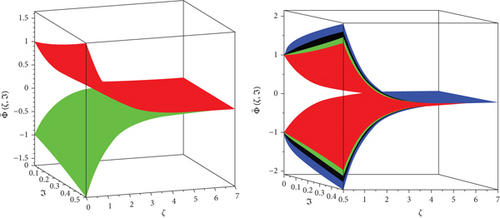
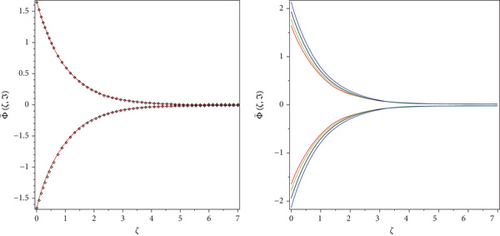
Figure 3 indicates how the efficiency of various (upper and lower bound accuracy) surface plots for example 1 connect with the fuzzy Atangana-Baleanu operator and Shehu transformation is being shown in this research. Figure 4 shows that the lower and upper bounded graph of two dimensional. The pattern identifies the fluctuation in the mapping on the space coordinate ξ with the considering of and the uncertainty parameter rε[0, 1]. The figure shows that, as time passes, the mapping will become more intricate.
Example 3. The third example is of a fuzzy fractional nonlinear homogenous gas dynamics equation along with a fuzzy initial condition, as follows
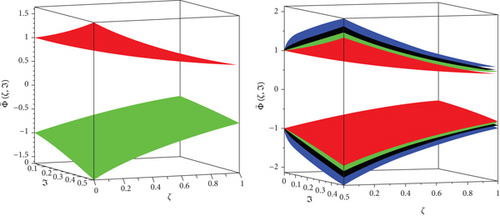
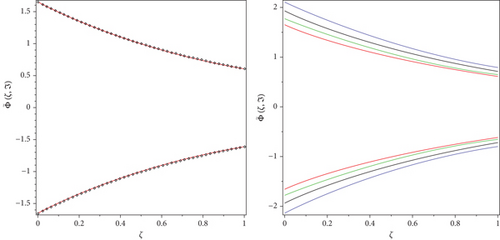
Figure 5 indicates how the efficiency of various (upper and lower bound accuracy) surface plots for example 1 connect with the fuzzy Atangana-Baleanu operator and Shehu transformation is being shown in this research. Figure 6 shows that the lower and upper bounded graph of two dimensional. The pattern identifies the fluctuation in the mapping on the space coordinate ξ with the considering of and the uncertainty parameter rε[0, 1]. The figure shows that, as time passes, the mapping will become more intricate.
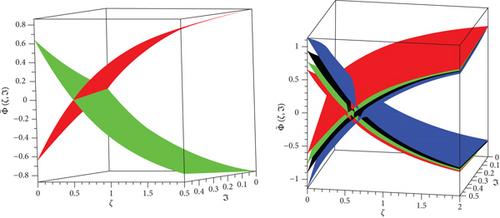

5. Conclusion
This investigation is aimed at providing a semianalytical result to the fuzzy fractional third-order KdV equations by considering the Atangana-Baleanu fractional derivatives. An important example has confirmed the result obtained. Also, we have provided graphs of the numerical solution at numerous fractional orders. As seen in the figures, the plots will close with the curve at classical order 1 when the fractional-order ν approaches its integer value. Hence, we noted that fractional calculus also identifies the global nature of the dynamics of the equations concerning the fuzzy idea. We will use this approach to more dynamics of the models that involve fuzzy with future study. In future research, this technique can be implemented to obtain analytical and approximate results of perturbed fractional differential equations under the uncertainty equipped with nonclassical and integral boundary conditions in the sense of the Atangana-Baleanu operator.
Conflicts of Interest
The authors declare that there are no conflicts of interest regarding the publication of this article.
Acknowledgments
The authors extend their appreciation to the Deanship of Scientific Research at King Khalid University, Abha 61413, Saudi Arabia, for funding this work through research groups program under grant number R.G.P-1/192/42.
Open Research
Data Availability
The numerical data used to support the findings of this study are included within the article.




